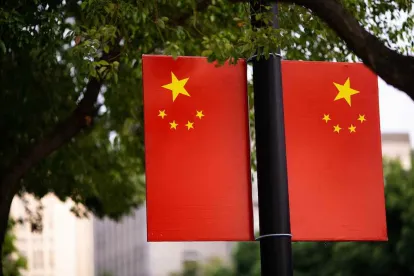On November 17, 2022 the Supreme People’s Court of China (no link provided as China is currently geoblocking the SPC website) held a press conference to announce the release of of people’s courts’ anti-monopoly and anti-unfair competition typical cases. The release is to “strengthen anti-monopoly and anti-unfair competition judging.” Of the antitrust (anti-monopoly) cases, two are directly related to intellectual property and are summarized here including one an AstraZeneca reverse payment case. The anti-unfair competition cases will be summarized in a separate article.

2. “Non-excitation switch patent infringement settlement agreement” horizontal monopoly agreement dispute case
——Anti-monopoly review of abuse of intellectual property rights
Case No.: 最高人民法院(2021)最高法知民终1298号
Note: Link to case not provide due to China’s geoblocking of case database Wenshu.
【Basic case】
In 2015, Taipu Company filed a lawsuit against Huaming for infringement upon its invention patent right for “a kind of non-excitation switch with a shielded device.” In January 2016, both parties entered into a “mediation agreement” (which was a settlement agreement without court confirmation), stipulating that: Huaming Company could only produce certain kinds of non-excitation tapping switches, and could only resell other kinds of non-excitation tapping switches to downstream customers through Taipu Company, and the sales price should be determined according to the supply price of Taipu Company. In overseas markets, Huaming shall act as the market agent of Tai Pu United, the company in which Taipu holds shares, and shall not produce by itself or act as an agent of any other enterprise for the same kind of products, and the sales price shall be consistent with the supply price of Taipu. In 2019, Huaming Company filed a lawsuit with the court, claiming that the settlement agreement involved in this case was a monopolistic agreement that violated the Anti-Monopoly Law and should be determined as invalid. The court of first instance held that the settlement agreement involved in this case was not a monopolistic agreement, and decided to reject all claims of Huaming Company. Huaming Company appealed. The Supreme People’s Court, as the court of second instance, held that if a patentee exceeds its exclusive right and abuses its intellectual property to preclude or restrict competition, it is suspected of violating the Anti-Monopoly Law. The mediation agreement involved in this case was not substantively related to the scope of protection of the patent right involved in this case, and its core was not to protect the patent right but use the patent right as a cover to actually pursue the effect of eliminating or restricting competition. The mediation agreement involved in this case constituted a horizontal monopoly agreement that divided the sales market, restricted the production and sales volume of commodities, and fixed commodity price, and violated the the Anti-Monopoly Law. The Supreme People’s Court rendered the final judgment, annulled the first-instance judgment, and confirmed that all the mediation agreements involved in this case were null and void.
【Typical meaning】
Patent right is a kind of legal monopoly right. The lawful exercise of patent right by operators is not restricted by anti-monopoly law, but the behavior of operators who abuse patent right to exclude or restrict competition is regulated by anti-monopoly law. This case clarifies the analysis and judgment standards for horizontal monopoly agreements involving patent licensing, and provides guidance on examining whether the mediation or settlement agreement reached by the parties to a patent infringement case violates the anti-monopoly law. The awareness of anti-monopoly rule of law is of positive significance.
4. Reverse Payment Agreement for Pharmaceutical Patent for Saxagliptin Tablets” dispute over invention patent infringement
—— Antitrust review in a non-competition cause of action case
Case No.: 最高人民法院(2021)最高法知民终388号
Note: Link to case not provide due to China’s geoblocking of case database Wenshu.
【Basic case】
AstraZeneca S. A. is the assignee of the patent for invention patent No. 01806315.2 for the treatment of diabetes, entitled “Cyclopropyl-fused pyrrolidine dipeptidyl peptidase IV inhibitors, preparation method and use thereof,” the patented product being saxagliptin tablets. In order to prevent the validity of the patent right from being challenged, the original owner of the patent involved in the case reached a “settlement agreement” with the invalidation requester (an affiliated party of Aosaikang), which stipulated that: the requester withdraws the invalidation request for the patent involved in the case, and the requester and its affiliates Only then can the patent involved in the case be allowed to be implemented more than 5 years before the expiration of the protection period of the patent right involved in the case. Later, the petitioner withdrew the request for declaration of invalidation as agreed, and the related party, Aosaikang implemented the patent involved in this case. Afterwards, AstraZeneca Inc. sued, claiming that Aosaikang had infringed upon the patent in question. The court of first instance held that: Aosaikang had the right to exploit the patents at issue according to the Settlement Agreement involved in this case, so it rendered a judgment to dismiss all claims of AstraZeneca LLC. AstraZeneca appealed, and later withdrew the appeal on the grounds that the parties had reached a settlement during the second instance. The Supreme People’s Court, as the court of second instance, held that the withdrawal of an appeal shall be reviewed in accordance with the law, and the Settlement Agreement involved in the case appears to be a “reverse payment agreement for pharmaceutical patents,” and the people’s court shall generally examine whether the patentee has violated the Anti-Monopoly Law and then decide whether to approve the withdrawal of the appeal. Upon examination, the Supreme People’s Court approved the withdrawal of the appeal in the final ruling after comprehensively considering the fact that the time limit for the protection of the patent right involved in this case has expired and other specific circumstances.
【Typical meaning】
A “reverse payment agreement for pharmaceutical patent” is an agreement under which the pharmaceutical patent holder promises to compensate the generic drug applicant directly or indirectly and the generic drug applicant promises not to challenge the validity of the drug-related patent right or delay entry to the market related to the patented drug. This case was merely a preliminary anti-monopoly review for withdrawing an appeal, and ultimately it was unclear from the specific circumstances of the case whether the settlement agreement involved in this case violated the Anti-Monopoly Law. However, the judgment of this case emphasized the necessity of timely and appropriate anti-monopoly review of the agreements under which the parties raised claims in the trial of non-compete cases, indicated the limits of and basic paths for the review of the “Drug Patent Reverse Payment Agreements”, and had positive significance in enhancing the anti-monopoly compliance awareness of enterprises, regulating the competition order in the drug market and guiding the people’s court to strengthen anti-monopoly review.
The full announcement made on WeChat by the Supreme People’s Court is available here (not currently geoblocked; Chinese only).



 />i
/>i

